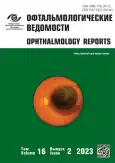Peripapillary intrachoroidal cavitation in myopia (clinical case)
- Authors: Suetov A.A.1,2, Doktorova T.A.2,3, Molodkina N.A.1, Boiko E.V.1,3
-
Affiliations:
- S. Fyodorov Eye Microsurgery Federal State Institution, Saint Petersburg Branch
- State Scientific Research Test Institute of Military Medicine
- North-Western State Medical University named after I.I. Mechnikov
- Issue: Vol 16, No 2 (2023)
- Pages: 109-115
- Section: Case reports
- Submitted: 20.01.2023
- Accepted: 09.04.2023
- Published: 14.07.2023
- URL: https://journals.eco-vector.com/ov/article/view/121331
- DOI: https://doi.org/10.17816/OV121331
- ID: 121331
Cite item
Abstract
In pathological myopia, axial elongation of the eye is accompanied by various changes of the fundus. The introduction of the method of optical coherence tomography into clinical practice made it possible to describe new variants of structural changes in myopia, in particular, peripapillary intrachoroidal cavitation. The article presents a clinical case and provides known data on this rare condition in pathological myopia.
Full Text
About the authors
Aleksei A. Suetov
S. Fyodorov Eye Microsurgery Federal State Institution, Saint Petersburg Branch; State Scientific Research Test Institute of Military Medicine
Email: ophtalm@mail.ru
ORCID iD: 0000-0002-8670-2964
SPIN-code: 4286-6100
МD, Cand. Sci. (Med.), ophthalmologist, senior research associate
Russian Federation, Saint Petersburg; Saint PetersburgTaisiia A. Doktorova
State Scientific Research Test Institute of Military Medicine; North-Western State Medical University named after I.I. Mechnikov
Author for correspondence.
Email: taisiiadok@mail.ru
ORCID iD: 0000-0003-2162-4018
postgraduate student, ophthalmologist
Russian Federation, Saint Petersburg; Saint PetersburgNina A. Molodkina
S. Fyodorov Eye Microsurgery Federal State Institution, Saint Petersburg Branch
Email: nina_molodkina@mail.ru
ophthalmologist
Russian Federation, Saint PetersburgErnest V. Boiko
S. Fyodorov Eye Microsurgery Federal State Institution, Saint Petersburg Branch; North-Western State Medical University named after I.I. Mechnikov
Email: office@mntk.spb.ru
ORCID iD: 0000-0002-7413-7478
SPIN-code: 7589-2512
МD, Dr. Sci. (Med.), professor, director; head of the Ophthalmology Department
Russian Federation, Saint Petersburg; Saint PetersburgReferences
- Markosian GA, Tarutta EP, Tarasova NA, Maximova MV. The fundus changes in pathological myopia. Russian journal of clinical ophthalmology. 2019;19(2):99–104. (In Russ.) doi: 10.32364/2311-7729-2019-19-2-99-104
- Nassar S, Tarbett AK, Browning DJ. Choroidal cavitary disorders. Clin Ophthalmol. 2020;14:2609–2623. doi: 10.2147/OPTH.S264731
- Freund KB, Mukkamala SK, Cooney MJ. Peripapillary choroidal thickening and cavitation. Arch Ophthalmol. 2011;129(8):1096–1097. doi: 10.1001/archophthalmol.2011.208
- Toranzo J, Cohen SY, Erginay A, Gaudric A. Peripapillary intrachoroidal cavitation in myopia. Am J Ophthalmol. 2005;140(4):731–732. doi: 10.1016/j.ajo.2005.03.063
- Spaide RF, Akiba M, Ohno-Matsui K. Evaluation of peripapillary intrachoroidal cavitation with swept source and enhanced depth imaging optical coherence tomography. Retina. 2012;32(6):1037–1044. doi: 10.1097/IAE.0b013e318242b9c0
- Yeh S-I, Chang W-C, Wu C-H, et al. Characteristics of peripapillary choroidal cavitation detected by optical coherence tomography. Ophthalmology. 2013;120(3):544–552. doi: 10.1016/j.ophtha.2012.08.028
- Shimada N, Ohno-Matsui K, Nishimuta A, et al. Peripapillary changes detected by optical coherence tomography in eyes with high myopia. Ophthalmology. 2007;114(11):2070–2076. doi: 10.1016/j.ophtha.2007.01.016
- Akimoto M, Akagi T, Okazaki K, Chihara E. Recurrent macular detachment and retinoschisis associated with intrachoroidal cavitation in a normal eye. Case Rep Ophthalmol. 2012;3(2):169–174. doi: 10.1159/000339292
- Ando Y, Inoue M, Ohno-Matsui K, et al. Macular detachment associated with intrachoroidal cavitation in nonpathological myopic eyes. Retina. 2015;35(10):1943–1950. doi: 10.1097/IAE.0000000000000575
- Mazzaferro A, Carnevali A, Zucchiatti I, et al. Optical coherence tomography angiography features of intrachoroidal peripapillary cavitation. Eur J Ophthalmol. 2017;27(2):e32–e34. doi: 10.5301/ejo.5000901
- Forte R, Pascotto F, Cennamo G, de Crecchio G. Evaluation of peripapillary detachment in pathologic myopia with en face optical coherence tomography. Eye. 2008;22:158–161. doi: 10.1038/sj.eye.6702666
- Anderson DR. Ultrastructure of human and monkey lamina cribrosa and optic nerve head. Arch Ophthalmol. 1969;82(6):800–814. doi: 10.1001/archopht.1969.00990020792015
- Wei Y-H, Yang C-M, Chen M-S, et al. Peripapillary intrachoroidal cavitation in high myopia: Reappraisal. Eye. 2009;23:141–144. doi: 10.1038/sj.eye.6702961
- Shimada N, Ohno-Matsui K, Yoshida T, et al. Characteristics of peripapillary detachment in pathologic myopia. Arch Ophthalmol. 2006;124(1):46–52. doi: 10.1001/archopht.124.1.46
- Yoshizawa C, Saito W, Noda K, Ishida S. Pars plana vitrectomy for macular schisis associated with peripapillary intrachoroidal cavitation. Ophthalmic Surg Lasers Imaging Retin. 2014;45(4):350–353. doi: 10.3928/23258160-20140617-03
Supplementary files










